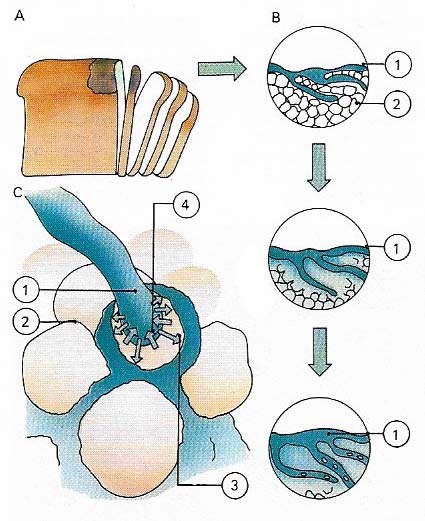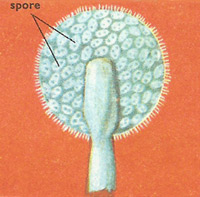mold

Figure 1. Three species of mold seen greatly enlarged. On the left is Mucor mucedo, in the center, Eurotium herbariorum, and on the right, Tamnidium elegans.

Figure 2. The common mold Mucor lives on dead organic material and is easily grown on damp bread (A). Within several days the bread sprouts a forest of black pin-like Mucor fruiting bodies. The mycelium (B) of the thread-like hyphae (1) ramifies through the bread particles (2). (C) Digestive enzymes (3) are secreted to break down the food outside the hyphae and allow it to be absorbed (4).
If you were to find a piece of cheese or a slice of bread that was moldy, you would probably throw it away without a moment's hesitation. Most people would do the same, because moldy articles are seldom of much use. There was the day in 1928 when Alexander Fleming noticed that a mold which was growing on one of his bacterial cultures had killed the dangerous bacteria growing nearby. Fleming's acute observation led to the discovery that a mold produces the wonderful life-saving drug that we know today as penicillin.
Bread mold
This is the most familiar mold of all, for, at one time or another, we must all have seen it growing on a piece of bread. Its scientific name is Mucor mucedo. Most of this mold consists of a mass of tiny branched filaments called hyphae, which branch out on the surface of the bread. This network of hyphae is called mycelium. A number of hyphae grow downwards from the mycelium into the bread, and these absorb nourishment for the mold as a whole.
 |
| The spores in the sporangium of Mucor mucedo.
|
Reproduction
The continued existence of the bread mold depends on its ability to produce spores which will blow about in the air and land upon suitable places in which to grow. Spore formation, or reproduction, in bread mold occurs in two ways, one an asexual method, in which a single plant forms spores, and the other a sexual method, in which two quite separate plants are involved.
Asexual reproduction is really quite simple. A number of hyphae grow upright from the mycelium of a single plant. The ends of these hyphae swell out to form a spore container or sporangium. These swollen-ended hyphae have given rise to the name 'pin mold' which is sometimes used for Mucor. The outer parts of each sporangium form into a number of spores, in a round shape, with thick walls, and the round formation becomes darker in color and covered with a coat of calcium oxalate. After a time the central part of the sporangium swells and bursts the outside wall, releasing the spores. These spores blow away and grow into new plants where they land.
Sexual reproduction is much less common, for it can occur only when the hyphae of two quite separate plants come into contact. Where hyphae from different plants touch,, a small club-shaped side branch grows from each in such a way that the ends of the two branches remain in contact. The tips of these branches fuse together to form a zygospore with a thick dark wall. After a time a hypha grows out of the zygospore and on its end there grows an asexual sporangium. Spores are formed in this sporangium which later blow away and grow into new plants.
 |
| The growth and reproduction of Mucor mucedo.
|
Different kinds of mold
Although everyone is familiar with molds and can recognise them easily enough, most people would find it difficult to say exactly what a mold is. This is not surprising, for the word 'mold' does not have an exact botanical meaning but is used rather carelessly to describe a large number of different species of fungi, most of which grow as small, flattish discs on the surface of dead materials.
Molds grow from tiny seeds that are known as spores. These spores are so small that they float about in the air and find their way almost everywhere. Spores that fall on to suitable 'soil' quickly germinate and grow into new molds. You can try this for yourselves by leaving a piece of bread on the table for a little while, so that a number of spores can fall on it. Of you then place the bread in a jam jar with a little water at the bottom for moisture, you will notice, after a few days, that the surface of the bread is covered with many little silvery patches. These are the mold Mucor mucedo. If you leave the bread for a little longer some greenish molds will probably appear. These are likely to be a species of Penicillium (probably not the one from which the antibiotic is made) and also species of Eurotium.
Molds, like all the fungi, do not contain chlorophyll, and so they cannot build up their cell substance from simple compounds like water and carbon dioxide, as do green plants. Instead, molds get their nourishment from the complex chemical compounds of the material on which they live.
Most molds are saprophytic – that is, they live on dead material, but a few are parasites living on live plants and animals.


